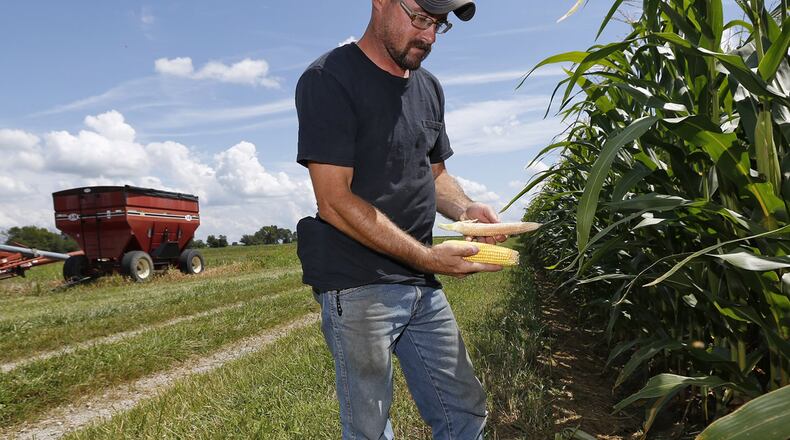In most years, farmers are done planting by Memorial Day weekend, but this year several farmers told the Dayton Daily News they weren’t able to start until the holiday because continued rainfall kept the ground from drying out.
“This is by far the worst year that I have had — from last fall when we started getting all the rain to this spring trying to fight the weather to get planted — it has been by far my worst,” said 36-year-old Greene County farmer Darren Reed. “I never remember, even as kid, trying to get crops out in November, December and guys even running in February trying to get their stuff out.”
»RELATED: Macy’s offers ways for shoppers to donate to shooting victims, families
Reed was able to get all of his crop planted, though some of it only looks “so, so” right now because it was three weeks late, he said. Others across Western Ohio have entirely empty fields.
More than 15 percent of Ohio’s 9.9 million acres went unplanted, according to data released this week by the United States Department of Agriculture. Nearly 1.5 million was covered by prevent plant insurance, which helps subsidize farmers who can’t plant at all.
That’s one in every seven acres, and the worst on record since the USDA began tracking in 2007, said Ty Higgins, Ohio Farm Bureau spokesman. The numbers could increase because not all farmers have returned their surveys, which are required annually to stay up to date on payment eligibility and calculate losses for disaster programs.
»RELATED: Macy’s offers ways for shoppers to donate to shooting victims, families
Nationally, just under 19.3 million acres weren’t planted, according to the data.
But even farmers like Michael Brehm of Darke County, who planted everything aside from some wet patches, aren’t expecting good crops this year. Only 3 percent of corn and soybeans are in excellent condition, far fewer than the 20 percent of corn and 19 percent of soybeans last year, according to Ohio’s most recent crop progress report.
“Things may look good, but you’ve got to remember what date it is. We’re so far behind,” Brehm said. “Soybeans have an internal time clock and I’m afraid we’re going to run out of sunlight.”
Usually by this time in the growing season beans are waist high and full of pods that have beans inside, kind of like a green bean, Brehm said. Corn would usually have ears with kernels that if popped, would be juicy like sweet corn.
Instead, corn is just now pollinating and farmers are starting to identify kernels. Only 35 percent of soybeans have started setting pods.
Brehm expects a 40 percent yield drop from last year in both corn and soybeans and a 30 percent drop from his average. Brian Harbage, a Clark County farmer, also expects his yields to drop about the same, more if farmers don’t get the rain they need now.
»BIZ BEAT: Three more local stores set to close after national retailer liquidates
Because the crops were planted in wet ground, they didn’t get a good root system. The lack of rain over the last few weeks has dried out the ground, and without good root systems or more rain to refill nutrients, the plants are struggling to gather food needed to grow.
There’s cracks in the ground so large that Harbage said he can fit his fingers in them.
Farmers have also worried about an early frost, but Storm Center 7 Meteorologist Jesse Maag said there are no indicators that a frost will come any earlier than the normal Oct. 22.
Tariffs have also been a major concern for farmers. With the shortage of crops expected, farmers planned for grain prices to increase, but trade tensions prevented any increase in price. The USDA report that came out also kept prices low because it wasn’t as bad as grain companies expected, Harbage said.
Ohio farmers are currently applying for tariff relief payments, but they’re only a band aid, Higgins said. The per acre dollar value is determined for each county reflective of how big of an impact the trade war has had on local farmers. Farmers will initially get half the payment and could get two more installments of a quarter each if the tensions continue.
“Farmers are dealing with some really heavy things right now from all sides,” Higgins said. “They’ve been kicked by the trade woes, not only with China but we need to get ratified the North American Free Trade Agreement 2.0…now we have low prices, which obviously doesn’t bode well for anybody across the corn belt, and then we have low production in Ohio and it just seems like growers across Ohio can’t catch a break.”
FIVE FAST READS
• The steps Connor Betts took to commit Ohio's largest mass shooting
• Ross Dress for Less store opens area store
• Back-to-school shopping begins early as schools prepare for openings
• DLM sends 4 students to highly competitive state bagger competition
About the Author
